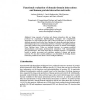796 search results - page 37 / 160 » A New Approach to Protein Identification |
HAPTICS
2007
IEEE
15 years 6 months ago
2007
IEEE
We present a new approach for evaluating a protein’s simulated trajectory via time-based haptic feedback. Molecular-scale trajectories are highly dynamic and thus pose new deman...
CSB
2005
IEEE
15 years 5 months ago
2005
IEEE
We describe a new method to predict the tertiary structure of new-fold proteins. Our two-phase approach combines the knowledge-based fragmentpacking with the minimization of a phy...
102
click to vote
BIOINFORMATICS
2007
14 years 12 months ago
2007
: Large amounts of protein and domain interaction data are being produced by experimental high-throughput techniques and computational approaches. To gain insight into the value of...
BMCBI
2008
14 years 12 months ago
2008
Background: In the past decades, various protein subcellular-location (SCL) predictors have been developed. Most of these predictors, like TMHMM 2.0, SignalP 3.0, PrediSi and Phob...
BMCBI
2008
14 years 12 months ago
2008
Background: The study of protein-protein interactions is becoming increasingly important for biotechnological and therapeutic reasons. We can define two major areas therein: the s...

